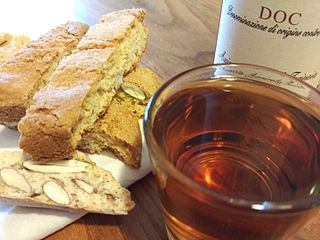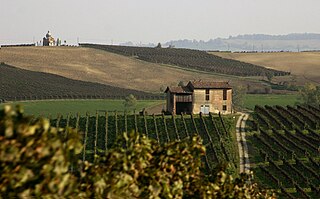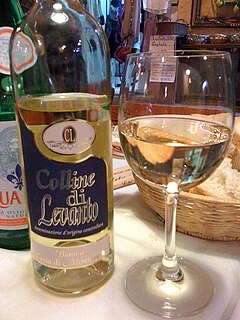
Sangiovese is a red Italian wine grape variety that derives its name from the Latin sanguis Jovis, "the blood of Jupiter". Though it is the grape of most of central Italy from Romagna down to Lazio, Campania and Sicily, outside Italy it is most famous as the only component of Brunello di Montalcino and Rosso di Montalcino and the main component of the blends Chianti, Carmignano, Vino Nobile di Montepulciano and Morellino di Scansano, although it can also be used to make varietal wines such as Sangiovese di Romagna and the modern "Super Tuscan" wines like Tignanello.

Italian wine is produced in every region of Italy, home to some of the oldest wine-producing regions in the world. Italy is the world's largest producer of wine, with an area of 702,000 hectares under vineyard cultivation, and contributing a 2013–2017 annual average of 48.3 million hl of wine. In 2018 Italy accounted for 19 percent of global production, ahead of France and Spain. Italian wine is both exported around the world and popular domestically among Italians, who consume an average of 42 litres per capita, ranking fifth in world wine consumption.

Vin Santo[vin ˈsanto] is a style of Italian dessert wine. Traditional in Tuscany, these wines are often made from white grape varieties such as Trebbiano and Malvasia, though Sangiovese may be used to produce a rosé style known as "Occhio di Pernice" or eye of the partridge. The wines may also be described as straw wines since they are often produced by drying the freshly harvested grapes on straw mats in a warm and well ventilated area of the house. Though technically a dessert wine, a Vin Santo can vary in sweetness levels from bone dry to extremely sweet. While the style is believed to have originated in Tuscany, examples of Vin Santo can be found throughout Italy and it is an authorised style of wine for several Denominazione di origine controllata (DOCs) and Indicazione geografica tipica (IGTs).

Capalbio is a comune (municipality) in the Province of Grosseto in Tuscany region of Italy, located about 150 kilometres (93 mi) south of Florence and about 45 kilometres (28 mi) southeast of Grosseto. Capalbio borders the following municipalities: Manciano, Montalto di Castro, Orbetello.

Montepulciano is a red Italian wine grape variety that is most noted for being the primary grape behind the DOCG wines Offida Rosso, Montepulciano d'Abruzzo, Montepulciano d'Abruzzo Colline Teramane, Rosso Conero and the DOC wine Rosso Piceno Superiore.

Straw wine, or raisin wine, is a wine made from grapes that have been dried to concentrate their juice. The result is similar to that of the ice wine process, but is a much older process and suitable for warm climates. The technique dates back to pre-Classical times with wines becoming fashionable in Roman times and in late Medieval/Renaissance Europe when wines such as Malmsey and Candia were highly sought after. Traditionally, most production of these wines has been in Greece, the islands off Sicily, Cyprus, Northern Italy and the French Alps. However producers in other areas are now using with the method too.

Lombardia (Lombardy) wine is the Italian wine produced in the Lombardy region of north central Italy. The region is known particularly for its sparkling wines made in the Franciacorta and Oltrepò Pavese areas. Lombardy also produces still red, white and rosé wines made from a variety of local and international grapes including Nebbiolo wines in the Valtellina region, Trebbiano di Lugana white wines produced with the Chiaretto style rosé along the shores of Lake Garda. The wine region currently has 15 Denominazione di origine controllata (DOC), 3 Denominazione di Origine Controllata e Garantita (DOCG) and 13 Indicazione Geografica Tipica (IGT) designations. The main cities of the region are Milan, Bergamo and Brescia. The region annually produces around 1.3 million hectolitres of wine, more than the regions of Friuli-Venezia Giulia, Marche, Trentino-Alto Adige/Südtirol and Umbria.
Vernaccia di Oristano is a white Italian wine grape variety grown on the island of Sardinia which makes a wide range of wine styles for the Denominazione di origine controllata (DOC) of Vernaccia di Oristano based in the province of Oristano. This includes both dry and sweet wines as well as fortified "sherry-like" wines aged in a solera. The grape has a long history on the island of Sardinia with Sardinians claiming that consuming ample quantities of wine produced from the grape as being responsible for low instances of malaria on the island.

Tuscan wine is Italian wine from the Tuscany region. Located in central Italy along the Tyrrhenian coast, Tuscany is home to some of the world's most notable wine regions. Chianti, Brunello di Montalcino and Vino Nobile di Montepulciano are primarily made with Sangiovese grape whereas the Vernaccia grape is the basis of the white Vernaccia di San Gimignano. Tuscany is also known for the dessert wine Vin Santo, made from a variety of the region's grapes. Tuscany has forty-one Denominazioni di origine controllata (DOC) and eleven Denominazioni di Origine Controllata e Garantita (DOCG). In the 1970s a new class of wines known in the trade as "Super Tuscans" emerged. These wines were made outside DOC/DOCG regulations but were considered of high quality and commanded high prices. Many of these wines became cult wines. In the reformation of the Italian classification system many of the original Super Tuscans now qualify as DOC or DOCG wines but some producers still prefer the declassified rankings or to use the Indicazione Geografica Tipica (IGT) classification of Toscana. Tuscany has six sub-categories of IGT wines today.
Drupeggio is a white Italian wine grape variety that is grown in the Central Italy wine regions of Tuscany and Orvieto. The grape is often confused for the white Tuscan variety Vernaccia di San Gimignano, which is also known under the synonym Canaiolo bianco and may be counted as one and the same in field blends.

Vespaiola is a white Italian wine grape variety planted primarily in the Veneto region of northeastern Italy, where it is often dried to produce passito style dessert wines. Along with Friulano, Vespaiola is an important component in the Denominazione di origine controllata (DOC) white wine of Breganze produced in the province of Vicenza.

The history of Chianti dates back to at least the 13th century with the earliest incarnations of Chianti as a white wine. Today this Tuscan wine is one of Italy's most well known and recognizable wines. In the Middle Ages, the villages of Gaiole, Castellina and Radda located near Florence formed as a Lega del Chianti creating an area that would become the spiritual and historical "heart" of the Chianti region and today is located within the Chianti Classico Denominazione di Origine Controllata e Garantita (DOCG). As the wines of Chianti grew in popularity other villages in Tuscany wanted their lands to be called Chianti. The boundaries of the region have seen many expansions and sub-divisions over the centuries. The variable terroir of these different macroclimates contributed to diverging range of quality on the market and by the late 20th century consumer perception of Chianti was often associated with basic mass-market Chianti sold in a squat bottle enclosed in a straw basket, called fiasco.
Abrusco is a red Italian wine grape variety grown primarily in the Tuscany region where it is a minor blending component permitted in the wines of Chianti. The grape has long history in the region and was mentioned in 1600, under its synonyms Abrostino and Colore, in the posthumously published work by Italian agronomist Giovan Vettorio Soderini Trattato della coltivazione delle viti, e del frutto che se ne può cavare. There Soderini notes that the grape was often used to add deeper, more red color to Tuscan wines.

The Colli Piacentini is an Italian wine region located at the western end of Emilia-Romagna. In 1967, it was given the Denominazione di origine controllata (DOC) quality designation. Within its boundaries are several smaller DOCs including Colli Piacentini Gutturnio, Monterosso Val D'Arda DOC, Trebbianino Val Trebbia DOC and Val Nur del Colli Piacentini DOC. The region has a long history of winemaking with fossilized vine roots and grape seeds excavated from the region showing viticulture taking place as early as 2000 BC. In Roman times, Julius Caesar's father-in-law Lucius Calpurnius Piso Caesoninus, grew grapes in the Piacenza hills.

Liguria is an Italian wine region located in the northwest region of Italy along the Italian Riviera. It is bordered by the Piedmont wine region to the north, the Alps and French wine region of Provence to the west, the Apennine Mountains and the Emilia-Romagna wine region to the east with a small border shared with Tuscany in the south-east along the Ligurian sea.

Nosiola is a white Italian wine grape variety that is grown in the Trentino region north of Lake Garda in the Valle dei Laghi. Here it is used in varietal Denominazione di origine controllata (DOC) wines and as a blending component in wines such as Sorni Bianco from Trento. It is also used to produce a dessert wine in the Vin Santo style from grapes that have been allowed to dry out prior to fermentation.
Bracciola nera is a red Italian wine grape variety that is primarily found in the Liguria and Toscana wine regions of western Italy. The only Denominazione di origine controllata (DOC) that Bracciola nera plays a significant role is in the Colli di Luni DOC of Ligura where the grape is permitted to be blended with Sangiovese, Canaiolo, Pollera nera, Ciliegiolo, Vermentino nero and other varieties. A late-ripening variety, Bracciola nera usually contributes acidity to blends.
Colombana nera is a red Italian wine grape variety that is grown in Emilia-Romagna and Tuscany. Despite similarities in name, the grape did not get its name from nor is it grown in the San Colombano al Lambro region of Lombardy nor is it permitted in the Denominazione di origine controllata (DOC) wine of the same name. Rather, ampelographers believe that Colombana nera is named after the Abbey of San Colombano located in the commune of Bobbio in the Piacenza province of Emilia-Romagna where the grape has had a long history of cultivation.
Besgano bianco is a white Italian wine grape variety that was historically used in the production of the dessert wine Vin Santo, blended with Malvasia Bianca Lunga and Verdea, but today is rarely planted and is more often used for table grape production than winemaking. The grape is also known as Colombana bianca but it is not a color mutation of the Tuscan and Emilia-Romagna wine grape Colombana nera.
Bigolona is a white Italian wine grape variety from the Valpolicella region of northeast Italy where it has been growing since at least the early 19th century. The wine has traditionally been used in the production of late harvest and botrytized dessert wines with the grape's synonym Smarzirola being derived from the Italian marcire meaning "to rot".














